Quick SCAN examples
A really nice SCAN challenge from Luc Taesch, in four parts, via Twitter:
- I need a ‘SCAN in 2mins’ simple explanation, for my CognitiveBias meetup
- I’d like to story tell a kid, discovering a topic, and going in the N > A > C > S way
- Or possibly an individual discovering and welcoming the world complexity, from apprentice to master, in the S > C > A > N order
- Would you have some good example in mind, like when you have to explain SCAN in an elevator pitch, maybe?
So here’s my response: I’ve highlighted the SCAN ‘domains’ in bold-italic and, usually, in ‘[..]‘ braces – for example, [Simple].
#1: ‘SCAN in two minutes’
(Luc’s own version of ‘SCAN in 2mins’ is the delightful ‘savoury storytelling’ of ‘A quick receipt to SCAN‘.)
What’s a quick way to make sense of just about anything – or more to the point, map out how to decide about something? Answer: Take a quick SCAN of it.
Think about, visualise, imagine the context that you want to explore. Imagine that as a ‘context-space’ for which you need a map.
Now sketch out a couple of lines at right-angles to each other, crossing over at bottom-left.
The vertical line marks out how much time we have left to think about things, before we must take action, at the NOW that’s represented by that bottom-line. Some way up there’s a kind of boundary where we switch from theory to practice, from plan to action.
The horizontal line describes a spectrum of uncertainty or uniqueness or unpredictability, from absolutely certain over on the left edge, to absolute uncertainty or unique over to the right, all the way to infinity. Again, there’s a kind of boundary some way across, from where doing the same things gives the same results, to where it probably doesn’t any more, or we have to do different things to get the same results.
That sketch would probably will look a bit like this:
Down in the bottom-left is Simple, real-time, and certain. We can do it, we know how to do it, it’s straightforward, follow the rules, follow the step-by-step instructions.
Towards the upper left it’s a bit more Complicated – away from real-time, but still certain. It might take a bit of time to work it out, but we know that with the right algorithms we can calculate our way to the one right answer.
As we move to the right, things are more Ambiguous – more uncertain, but we still have time to think and to explore. We assess the trade-offs, we look for patterns and guidelines that will help us make sense of these ‘problems in the wild‘.
And as we come back towards real-time, yet with things still uncertain, we move into the Not-known – no-idea, none-of-the-above, that kind of experience. As perhaps the only place where anything new can arise, yet often decidedly scary, we rely on principles to give a sense of direction and purpose amidst the unknown.
Every context has its own ever-changing mix of Simple, Complicated, Ambiguous and Not-known. And it’s kind of recursive – the pattern repeats at every level – so something that might seem Simple often includes hidden areas of Complicated or Ambiguous or Not-known, or something supposedly Not-known will usually include something Simple enough to give us a sort-of-known start-point.
So in practice we dance around the context-space, continuously moving from one domain to another – Simple, Complicated, Ambiguous, Not-known. The trick is in noticing ‘where we are’ at every moment, and using the right tactics – rules, algorithms, patterns, principles and so on – for the domain we’re in at each moment.
(For real-world examples of how to use this in business-practice, see ‘SCAN as decision-dartboard‘ and ‘SCAN – some recent notes‘.)
(For a perhaps trivial yet practical illustration of how sensemaking and decision-making actually work at real-world speeds, see ‘SCANning the toaster‘.)
(The following ‘stories’ show a fairly linear sequence in SCAN, as per Luc’s initial request. In practice, though, the processes are much more fractal and ‘random’ – as illustrated well in the ‘SCANning the toaster’ example.)
#2a: The toddler’s tantrum (N>A>C>S>N)
(The idea for this one is lovingly lifted from a Posy Simmonds cartoon I saw many years ago…)
Unka Andrew says I’m so lucky to have a new baby brother to play with. [‘The New’ – Not-known]
No, I’m not lucky! – he’s smelly, he’s horrid, and Mummy plays with him all the time ‘stead of me! Don’t want to play with him! Don’t want him! [emotional response to Not-known]
Play with him? Like a toy? Sometimes if I bang my toys hard they take them away… [pattern and probability – Ambiguous]
If I hit him they’ll take him away. [calculated plan, with internally-consistent logic – Complicated]
(Climbs onto mother’s lap, cuddles close, tries to push baby out of the way, then hits him hard…) [acts out the logic of the plan – Simple]
“Gemma! How could you be so naughty? Go to your room at once!” [unexpected outcome – Not-known]
#2b: The scientist’s story (N>A>C>S (>N))
(For an enterprise-architecture variant of this, with four case-examples, see my 2011 post ‘What I do and how I do it‘.)
What do I do? I suppose I’d start with an idea, an observation, often something that seems to come up ‘out of nowhere’ – though there’s usually a lot of preparation behind it, too. [setup for and in Not-known]
On the basis of those ideas or observations, I’d stop and think for a while, and work up some kind of hypothesis – something I can test. [Ambiguous]
I’d then test that hypothesis in an experiment, look at the results, rethink my hypothesis, and test again. [back and forth between Ambiguous and Not-known]
Once my hypothesis starts firming up, I’d aim to identify clear common factors, for a theory that could be used for formal prediction in that type of context. [Complicated]
In practice, I would probably have to revise my hypotheses and theory on the basis of responses from peer-review and the like. [back and forth between Complicated and Ambiguous, and probably Not-known too]
Once the theory is settled, I would aim to simplify it, refine it down some kind of law in easily-expressible form. [Simple]
Again, it can take a lot of back-and-forth refinement to go from the initial complications to a simple law. [between Simple and Complicated, often back to Ambiguous and maybe even Not-known]
The one problem with law is that, once we get there, we tend to think that that’s the end of it. As Thomas Kuhn says, sometimes it needs a scientific revolution to get us to start observing the real-world again – to look into what’s still not-known and find new ideas once more. [from Simple to Not-known]
#3a: The trainee’s tale ((N>) S>C>A>N)
I start out by knowing nothing at all – or almost nothing, anyway. [Not-known]
They give me basic stuff to work on, and tell me to follow the rules, the step-by-step instructions. [Simple]
If anything goes wrong, I’m stuck, because I don’t know what to do. [Simple to Not-known, but not able to resolve]
After a few weeks, they start to teach us some of the theory. [Complicated]
We don’t get so easily stuck, but we have to stop and think about it – though it’s still just fancier rules, of course. [Simple to Complicated, and back again]
When we’ve finally understood all the theory, they show us that it doesn’t always work anyway – that there are all kinds of special-cases and stuff like that. [Ambiguous]
We have to learn the difference about when the standard way works, and when there’s a special-case we have to solve by some kind of experiment. [from Complicated to Ambiguous and back again]
And once we’ve made sense of that, they tell us that actually almost everything is a kind of special-case, or has special-case bits in it – and we have to be able to work it out and make it work on our feet, on the fly. [Not-known]
Real mastery is when we can handle all of it – anything that comes our way. [anywhere from Simple to Complicated to Ambiguous to Not-known, all as appropriate]
But we never do really get all the way there, do we!
#3b: The quality-manager’s quest (S>C>A>N)
Our quality-management is based on the ISO9000:2000 series of standards.
At the base-level, we have step-by-step work-instructions – what to do, when, how, with-what and so on. [Simple]
Whenever the work-instruction goes out of date – such as when we’ve changed to a different type of machine, or sometimes a new product – we go up to the procedure, to define a new work-instruction. This tells us what needs to go into a work-instruction, and also gives a bit more detail about the who – the rules, roles and responsibilities – and the underlying why. [Complicated]
When we need to change the procedure – for example, we’re changing a whole product-family, or to a completely new kind of service-offering – we go up again to the policy, to define new procedures, and new work-instructions to implement them. It’s a bit like a procedure, but there’s much more emphasis on the why, to help deal with special-cases. [Ambiguous]
When we find ourselves in circumstances where even the policy is not enough, we turn to the overall vision and its guiding-principles. That’s always there, everywhere, as the ultimate anchor for the entire quality-system. [Not-known]
#4: The surgeon’s story
(This section is derived from slides 97-100 of my slidedeck ‘Same and different: architectures for mass-uniqueness‘, originally presented at Open Group London, October 2013.)
When we’re planning for a complex operation on a patient – removal of a life-threatening cancer, for example – we might map out all of the factors and the intended and potential activities, in terms of how far ahead of the actual operation we need to do them [vertical dimension in SCAN], and the amount of uncertainty we might face about that item [horizontal dimension in SCAN]:
There are some things we want to be absolutely certain about. We need to plan the operation for the right patient, and what we’re going to do; we need to book the operating-theatre; and define the requirements for equipment and consumables. Just before we start, we need to make sure that we do have the correct patient and consumables. And during and after the operation, we need to ensure that all the correct records are created and kept. These are all simple things, but we do need to get them right. [leftward-side of SCAN frame – Complicated to Simple]
There are always some uncertainties, of course. For example, we might have a last-minute change in the surgical-team, or someone might still be using our operating-theatre at the time we were scheduled to be in there. We can never quite plan for these, but we have standard procedures to follow when they do happen. [mid-region of SCAN frame]
And then there are the emergencies of various kinds. Some of them are almost routine, we might say, such as where another family-member gets upset about the risks of the operation, and needs to be helped by our family-support team. We’d aim to have standard protocols for all of those, especially the ones that tend to happen before or outside the operating-theatre. Other emergencies definitely should be non-routine, but medicine is always a bit unpredictable, and they do happen, such as where something goes wrong on the operating-table: and that’s where the combined skills of the surgical-team really come into play. [rightward-side of SCAN frame – Ambiguous to Not-known]
Simple tools such as checklists do help us to keep some of the uncertainties at bay, and respond better to the emergencies when they do occur. [reduce risk of transition from Simple to Not-known, and recover in real-time from Not-known back to Simple]
Mapping it all out in this way is quite straightforward, really, but it does help us to get clear on what has to happen when, with whom, and why.
—
That’s it for now: I hope it makes it clearer about how SCAN can be used in practice, anyway.
Over to you for comments, as usual?
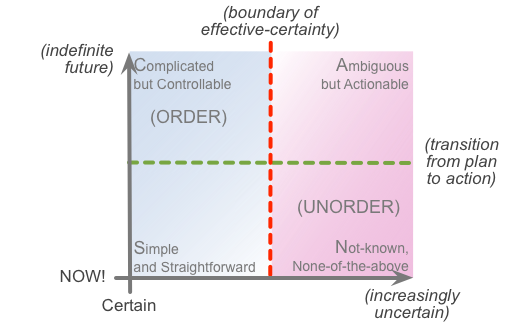
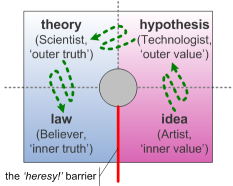

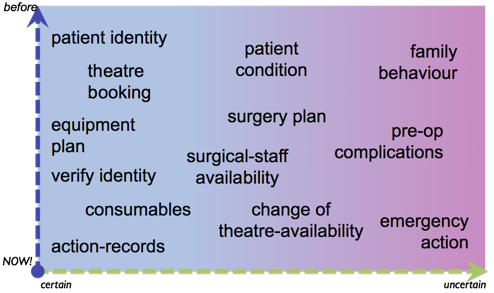
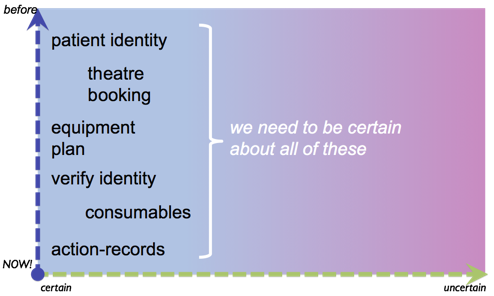
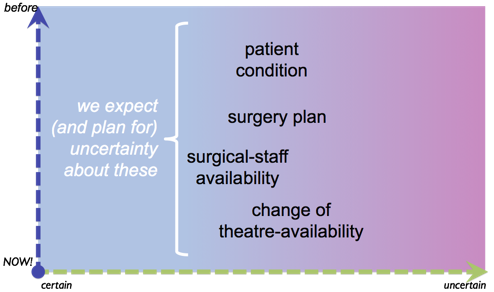
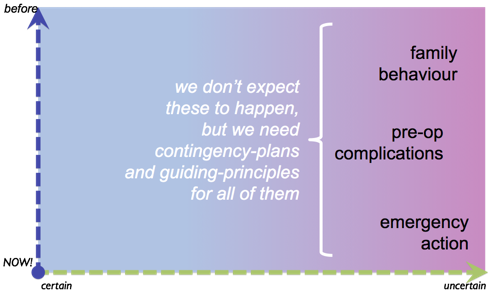
Well done TOM ! you were quite up to the challenge !! quite a good summary of SCAN and its usages ( for the “layman” 🙂
I particularly like the toddlers tantrum, as I feel that the difference leaving the C to the A sector is signaled in the stomac… and this uncomfortable feeling ( fear, uncertainty, doubt) that may push some back in the C quadrant.
Not everybody is ready to live in a magic world 🙂
I quite like the shades of the #4: surgeon… because real world is not black and white with straight lines…
Many thanks, Luc – glad it (sort-of?) satisfies your initial request? 🙂
(I presume the “Not everybody is ready to live in a magic world” comment is about my ‘Bending reality’ post? Yes, that was indeed the key point there – that the perceived ‘need’ to avoid the emotional-discomfort of the ‘edge of panic’ (actually more severe between Simple and Not-known than between Complicated and Ambiguous, because there’s less time-pressure in the latter) is one of the key drivers for hiding out in the over-certainty of the Complicated.)